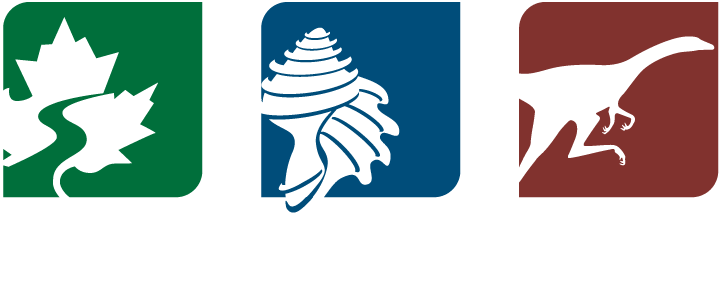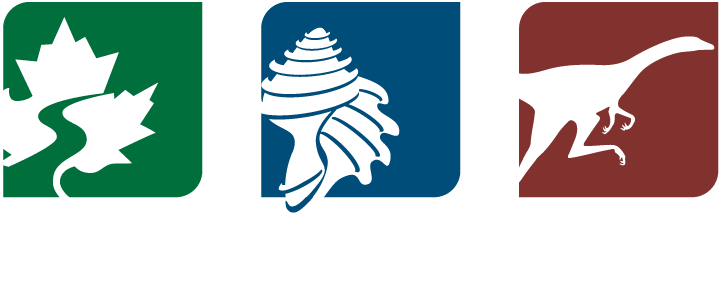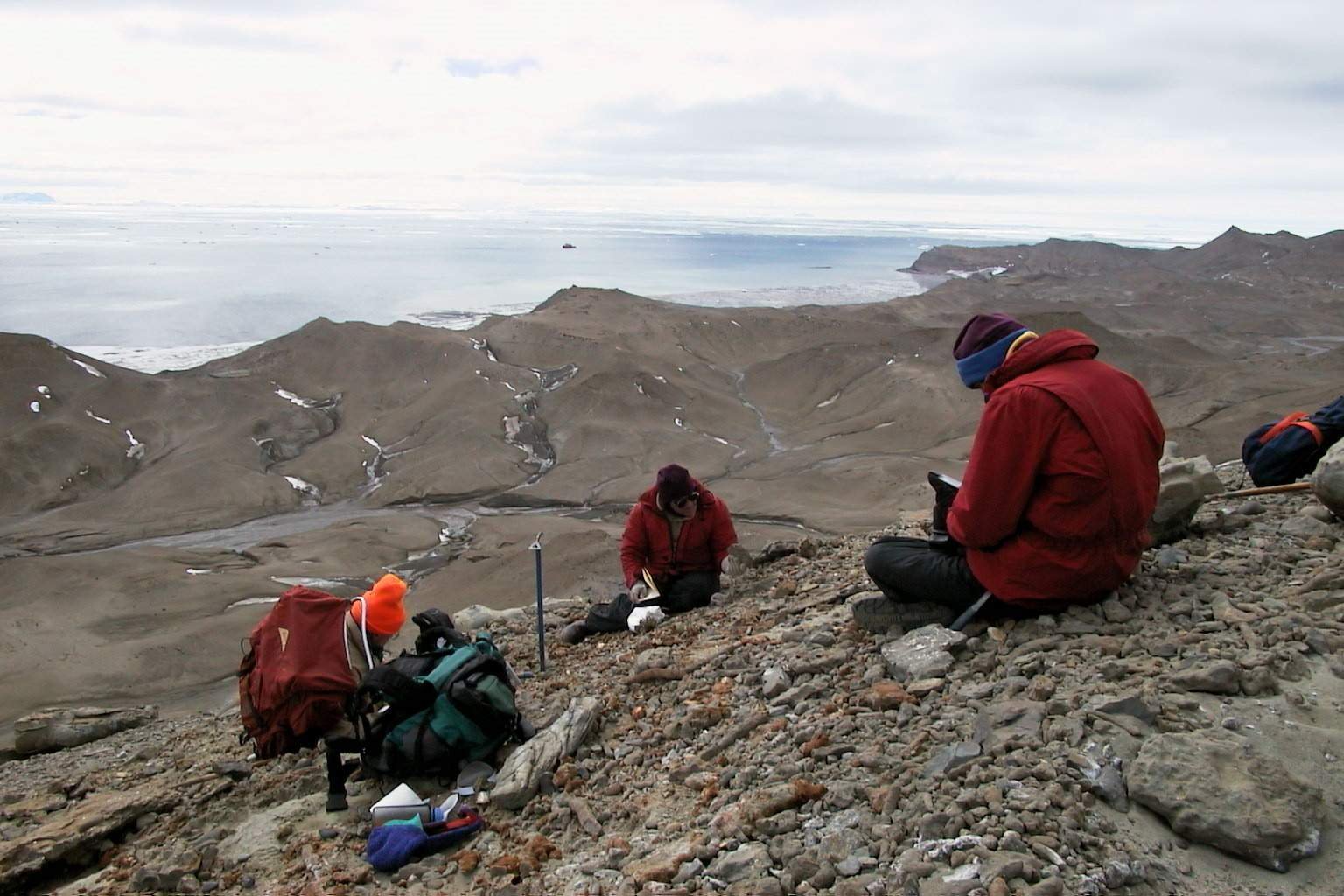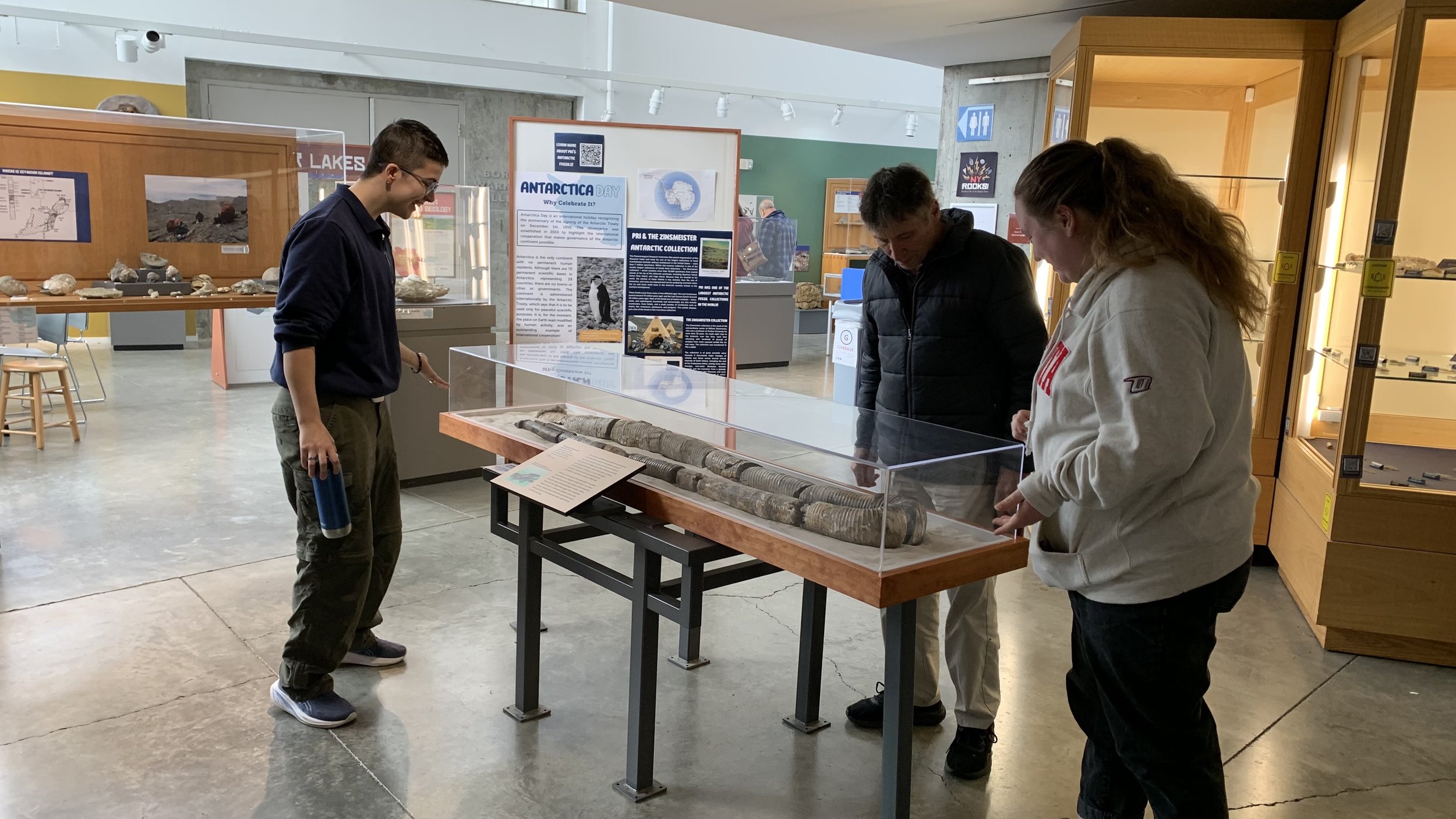The Antarctic Fossils of PRI
Although it is far away from Ithaca, New York (about 11,800 km, or 7,400 miles, to be precise), the tip of the Antarctic Peninsula is well represented in the enormous fossil collections held by the Paleontological Research Institution (PRI) in Ithaca. PRI’s collection includes more than 35,000 specimens from Antarctica, making it one of the largest such collections in the world.
How did so many fossils from Antarctica come to a museum in upstate New York? It began with the work of William Zinsmeister, who was a professor at Purdue University for more than three decades, starting in 1983. Beginning in 1975, he participated in or led numerous field parties to the southern end of the world, including ten trips to Antarctica and six to Patagonia and Tierra del Fuego (the southern end of South America). Eight of these trips were to Seymour Island, on the tip of the Antarctic Peninsula. Zinsmeister began his career, however, on the opposite end of the globe – working for Mobil Oil above the Arctic Circle. He recalled that he “got a call from a fellow at Ohio State back in the mid ‘70s who wanted to know if I wanted to go to Antarctica. I figured I had been to the Arctic, so I go to Antarctica and little did I know I would spend the rest of my life almost commuting to Antarctica…”. Indeed, Bill became one of the world’s authorities on the paleontology of the southern continent, publishing dozens of papers on it over his career, many of them based on fossils he had collected there. Approaching retirement from Purdue in 2006, he donated his collection to PRI.[1]
The Zinsmeister collection includes material from several other islands in addition to Seymour, including James Ross, Snow Hill, and Vega Islands. Seymour is especially attractive to geologists because of its low elevation, which renders it almost completely ice-free. So there rocks are exposed and can be studied by scientists in the almost around-the-clock light of the Antarctic summer (winter in the northern hemisphere). The Zinsmeister fossils come from rocks deposited over a time interval of about 40 million years, from the late Cretaceous (about 80 million years ago) to the late Eocene Epoch (about 40 million years ago).
The collection is of especially great scientific value because it documents major changes of climate and biology across several critical intervals of Earth history, including the end of the Cretaceous (when, among many other changes, non-avian dinosaurs became extinct), and the transition from a globally warm world of the late Mesozoic and early Cenozoic to the modern world in which there is ice at both poles. Seymour Island has the most complete series of rocks on both sides of the end-Cretaceous boundary anywhere in the southern hemisphere.
Fig 1. From left to right: A) Location, geologic map, and stratigraphic column of Seymour Island, Antarctica (adapted from Stilwell et al. 2004) B) Collecting fossils on Seymour Island. Courtesy of Linda Ivany. C) William Zinsmeister in 1982 posing with a collection of ammonites.
Geology and Fossils
Seymour Island is located at the northern tip of the Antarctic Peninsula (64º 17’ S) (Figure 1). The layered sedimentary rocks on the island consist of a pile approximately 1600 m (5250 feet) thick of siltstones and silty sandstones exposed over an area of approximately 70 square kilometers (27 square miles). These sediments make up the most complete, well-exposed section this age range in the Southern Hemisphere and one of the world’s most important localities for studying this period of Earth history. They have been studied intensively by geologists and paleontologists for more than a century, and especially since the 1970s.[2]
The Cretaceous portion of the Seymour Island section consists of approximately 1000 m (3280 ft) of mostly highly fossiliferous sediments (apparently accumulated very rapidly, by geological standards, over less than 4 million years) assigned to the López de Bertodano Formation. The fossils in these sediments include more than 100 species of mollusks (especially ammonites), crustaceans, echinoderms, brachiopods, and trace fossils (Figure 2), most found nowhere else.[3] It also includes vertebrates, such as sharks, bony fishes, plesiosaurs, and mosasaurs (Figure 3). The most spectacular single specimen in the Zinsmeister collection at PRI is a giant heteromorph ammonite from the López de Bertodano Formation (see below).
The boundary between the Cretaceous period and the overlying Paleogene period (known as the K-Pg) occurs within the upper part of the López de Bertodano Formation, and consists of a nearly continuous sequence of sediments deposited in a moderately deep marine environment. The boundary is exposed for approximately 7 km (4.3 miles) across the southern third of the island (Figure 4). It is among the most complete and fossil-rich K-Pg sections in the world, and has been studied by numerous teams of scientists interesting in the environmental and biological changes that occurred over this critical interval of Earth history.[3] The section contains a layer enriched in the element iridium, a result of the asteroid impact at the boundary, and also a layer of abundant fossils of fish apparently killed suddenly by the impact, on which Bill published a widely-cited paper.[2]
The Paleogene section on Seymour Island begins with includes approximately 90 m (295 ft) of the upper portion of the López de Bertodano and Sobral formations. Paleogene marine faunas are rare in the Southern Hemisphere, and the fossil fauna preserved in the Seymour Island section is the sole known assemblage from the early Paleocene, at the very beginning of the Paleogene (Figure 1). This section and its diverse and abundant fauna have been interpreted as containing the extinction-survival-recovery phases succeeding the K-Pg mass extinction event.[4]
Overlying the Sobral Formation is the La Meseta Formation, which is also extremely rich in fossils, including clams, snails, crustaceans, early whales, penguins, and driftwood (Figures 2,3). The La Meseta fossils provide an excellent setting within which to document the timing and magnitude of Eocene climate change, and to infer its effects on the evolution of high-latitude marine life. For example, although cool temperatures have long been thought to be a cause of longevity in marine animals (such as the modern bivalve Arctica islandica from Iceland, which can live more than 500 years), studies of the oxygen isotopes in carefully sampled growth increments of some Antarctic fossil bivalves that lived in warm climates reveal that they may have lived for more than a century, suggesting that food limitation associated with six months of darkness each year may contribute to long life spans (Figure 5).
Fig 2. Photos of non-vertebrates from the Zinsmeister collection. A) Gastropods, Colposigma sp., Seymour Island, Eocene, PRI 63064. B) Ammonite, Pachydiscus sp., Seymour Island, Cretaceous, PRI 65424. It is 13 inches in diameter.
Fig 3. Photos of vertebrates from the Zinsmeister collection. (From top to bottom). A) Penguin femur fragment, PRI 1067. B) Plesiosaur vertebra, Seymour Island, Cretaceous, PRI 1418. C) Shark vertebrae Seymour Island, Cretaceous, PRI 5076.
Fig 4. Field photo of K-Pg boundary on Seymour Island. Photo courtesy of the British Antarctic Survey via James Witts, Natural History Museum, London.
Fig 5. A) (Above) A sawed half of a Lahillia sp. coated in resin from the Zinsmeister Collection, Seymour Island, Paleocene, PRI 62029. B) (Below) Shell cross section of a Lahillia encompassing part of its growth history, with years of growth indicated above the shell. From Moss et al. (2017), courtesy of Linda Ivany.
Fig 6. A) The large specimen of Diplomoceras in the field soon after its discovery by Anton Oleinik (left), with Bill Zinsmeister (right).
Fig 6. B) The heteromorph after being cleaned and prepared. Top: original fossil. Middle: missing sections restored. Bottom: drawing of reconstructed shell.
The Giant Paperclip
The most spectacular fossil in the Zimsmeister collection looks like a giant paper clip, or a large, ribbed trombone slide. It is a very large and very unusual ammonite called Diplomoceras maximum (Figure 6). Ammonites are a group of shelled cephalopods – distant relatives of the modern chambered nautilus -- that became extinct at the end of the Cretaceous. Most ammonite shells are coiled in a single plane like a coil of rope or garden hose. Some ammonites, however, have very different shell shapes -- coiling 3-dimensionally or uncoiling or not coiling at all. These ammonites are called heteromorphs (meaning “different shape”).
Diplomoceras has been found in late Cretaceous rocks in many places around the world, including , Europe, Asia, Greenland, Alaska, Australia, and New Zealand. The Zinsmeister PRI Diplomoceras is the largest of its kind known, and probably the largest heteromorph of any kind in the world. It was found on Seymour Island by Bill’s graduate student, Anton Olenik (now a professor at Florida Atlantic University), during the field season of the austral summer of 1994-95. He related the moment of discovery in an article for PRI’s quarterly magazine American Paleontologist in 2010:
“The location itself was a 3-4 meter (10-13 foot) high bluff formed at the time by dry crumbly siltstone on the side of the valley. The steep nature of the outcrop in a landscape shaped by loosely consolidated sediment indicated a relatively fresh collapse of the slope. When I first looked at the outcrop, I saw only the two ends of the specimen, anchored by the ‘hooks’ (turns of the whorls) to the sediment. The rest of it – several tube-shaped pieces of the shaft – was laying at the base of the outcrop, only centimeters away from rolling down the slope to disappear into the oblivion of wet mud in the valley below. I happened to be there, during at brief window in time, shortly after this unique and fragile fossil was exposed and not long before it would have been destroyed forever. Excavation was time consuming but not too difficult, thanks to the surrounding unconsolidated sediments. Carrying the entire animal the 8-9 kilometers (5-6 miles) back to Marambio Base [the Argentinian station on the island], in my pack, across steep slopes and valleys filled with soupy mud, was quite another matter, but leaving even a small piece of it on the outcrop to ‘pick up another day’ was simply not an option.”[7]
This fossil is indeed remarkable. It is more than 2 meters (6 feet) long (4 meters or 12+ feet if you uncoil it). And its shell resembles no living animal. Just how did such a large and bizarre animal live? Paleoartists (including Anton himself) have depicted it as a mobile open-water or close-to-the seafloor predator (Figure 7A,B). But such ideas probably do not take into adequate account how the animals lived during the times when the “U-turns” or “hooks” of the shell were forming. Like all mollusk shells, ammonite shells grow incrementally at the large open end. How did the animal manoeuvre and feed when this end was changing to face the other way? Recent research on this question comes from Linda Ivany, a professor of Earth Science at Syracuse University. Linda reasons that Diplomoceras floated more or less passively in the water column, feeding on plankton, rather than being an active hunter. Based on measurements of the carbon and oxygen isotopes of other specimens of the same species in the Zinsmeister collection, Linda concludes that the animal grew more rapidly at the hooks, in order to “get around those corners” quickly. More surprisingly, Linda reasons that this ammonite may have been over 200 years old when it died.[8]
Mass Extinction
Debate continues among scientists about the nature of the mass extinction event between the Cretaceous and Paleogene periods, which is one of the “big five” mass extinctions that have occurred on Earth over the past half-billion years. While almost all researchers accept that a large asteroid struck the Earth at this time, there is also strong evidence for the occurrence of enormous volcanic eruptions in India at around the same time, which could also have contributed to catastrophic environmental change. The Zinsmeister Antarctic collection at PRI has played an important role in this debate. In the years just after the asteroid impact theory was published, Bill Zinsmeister was a strong critic of the idea, arguing that the data from Seymour Island did not support it. In later years, he was more accepting of the impact hypothesis. More recently, a paper by James Witts of the Natural History Museum in London and colleagues published in 2016 based in part on data from the Zinsmeister collection argues that the extinction was sudden instead of gradual, and therefore more likely to have been caused by an extraterrestrial impact than volcanoes erupting over many years.[9]
Fig 7. Two life restorations of Diplomoceras. (Top) A) By James Mackay (used with the artist’s permission). (Bottom) B) By Anton Oleinik (from Oleinik, 2010).
Biological Response to Ancient Climate Change
Globally warm (“greenhouse”) climates prevailed throughout the Cretaceous and Paleogene periods. Pole-to-equator temperature gradients were low, and the high latitudes were relatively warm and largely ice free until the late Eocene. The Zinsmeister fossils from Seymour Island document how high-latitude marine life changed as the Earth’s climate cooled during late Eocene time, which included the beginning of glaciation on Antarctica and the initiation of the current “icehouse” climate regime. This cooling trend is one of the fundamental factors leading to the establishment of present-day oceanographic and atmospheric circulation, in which cool water at the poles sinks, due to its higher density, and “stirs” the ocean bottom water, moving it like a conveyor belt around the world). The Cretaceous and Paleogene fossils from Antarctica also tell us about an environment not currently represented anywhere on earth – a high-latitude setting with near darkness for half the year where waters were comparatively warm and ice-free.[10]
Prior to late Eocene cooling, the marine communities of Antarctica were broadly similar to other faunas around the globe, which were dominated by bivalve and gastropod mollusks. The cooling trend ultimately resulted in the polar climate and bottom-living community found in Antarctica today, which is dominated by assemblages of echinoderms, including ophiuroids (brittle stars) and stalked crinoids. Declining temperatures are also associated with disappearances of crabs, sharks, and most bony fishes, which may have resulted in a drop in total predation. The evolution of these high-latitude faunas during the Paleogene is especially important as they may represent the source of new species for many southern hemisphere warm water faunas. The Seymour Island fossils are also representative of numerous distinctive organisms that adapted in a variety of unique ways to their high-latitude environments, and so are informative of evolutionary processes generally.
Fig 8. Guests looking at the remarkable Diplomoceras maximum fossil at the Museum of the Earth, Ithaca, NY.
A Resource for Continuing Research and Education
Bill Zinsmeister collected fossils in Antarctica primarily for research – to document the geology and paleontology of a remote location, to test ideas that had been proposed by the few adventurous explorers who had come before him, to find answers to fundamental questions about the history of the Earth, its climate, and its life. But the collection he built had done much more. The fossils played important roles in the education and research of his students at Purdue and many of his colleagues in other institutions over many years. After coming to PRI in 2009, they were catalogued and curated, and digital records and photographs of many have been posted online to be accessible to researchers. This means that they can be the basis for new research by new generations of scientists, including undergraduate and graduate students at Cornell and scientists who have come to visit the collection from around the world. Some of these researchers have reached conclusions different from Bill’s original ideas. In other words, the collection has served as the basis for repeated scientific investigations as techniques and thinking changed. Had the fossils never been collected, or if the collections had not been kept and cared for, the opportunity for continuing research and advancing knowledge would have been lost. Some of the fossils – including the spectacular Diplomoceras – are on public exhibit in PRI’s Museum of the Earth, where visitors from all walks of life, most of whom will never see Antarctica in person, can experience first-hand a journey to a very different place and time. The Zinsmeister collection is thus a perfect example of the varied and essential value of natural history collections. They preserve treasures from the natural world that might otherwise be lost; they take us where we cannot otherwise go; they answer questions and solve problems their collectors might not have imagined.
Acknowledgements
Thanks to Greg Dietl, Linda Ivany, Jeffrey Stillwell, and James Witts for comments on previous drafts, and Whitney Ribeiro for editorial assistance.
Footnotes
[1] PRI presented its Gilbert Harris Award for career achievement in systematic paleontology to Bill in 2009 [see here]. A complete list of his papers is here. Curation and digitization of the Zinsmeister collection at PRI, as well as all of Bill’s field work in Antarctica, was supported by the National Science Foundation.
[2] Zinsmeister (1988).
[3] Tobin et al. (2012); Witts et al. (2015, 2016).
[4] Stillwell et al. (2004); Beu (2009).
[5] Zinsmeister (1984); Stilwell and Zinsmeister (1992).
[6] Moss et al. (2017). The element oxygen naturally occurs in two forms or isotopes which differ in their number of neutrons, oxygen 16 and oxygen 18. Animals like mollusks take oxygen into their shells as they secrete them, and the ratio of these two oxygen isotopes in the shells varies with temperature: higher amounts of oxygen 16 indicate warmer temperatures. This technique is widely used to reconstruct ancient temperatures in geological time.
[7] Oleinik (2010, p. 11).
[8] Linda Ivany, unpublished research.
[9] Witts (2016).
[10] Moss et al. (2017).
References and Further Reading
Beu, A.G., 2009, Before the ice: biogeography of Antarctic Paleogene molluscan faunas. Palaeogeography, Palaeoclimatology, Palaeoecology, 284: 191–226.
Feldmann, R.M., and M.O. Woodburne, eds., 1988, Geology and paleontology of Seymour Island, Antarctic Peninsula. Geological Society of America Memoir 169, 566 p.
Judd, E.J., Ivany, L.C., DeConto, R.M., Halberstadt, A.R.W., Miklus*, N.M., Junium, C.K., Uveges, B.T. (2019) Seasonally resolved proxy data from the Antarctic Peninsula support a heterogeneous middle Eocene Southern Ocean. Paleoceanography and Paleoclimatology, v. 34, pp. 787-799
Moss, D.K., L.C. Ivany, R.B. Silver, J. Schue, and E.G. Artruc, 2017, High-latitude settings promote extreme longevity in fossil marine bivalves. Paleobiology, 43(3), 365–382. DOI: 10.1017/pab.2017.5
Oleinik, A., 2010, Hooks and shafts come together in a fragile giant from Antarctica. American Paleontologist, 18(2): 10-13.
Stilwell, J.D., and J.A. Long, 2011, Frozen in time. Prehistoric life in Antarctica. CSIRO Publishing, Collingwood, Victoria, Australia, 237 p.
Stilwell, J.D., and Zinsmeister, W.J., 1992, Molluscan systematics and biostratigraphy. Lower Tertiary La Meseta Formation, Seymour Island, Antarctic Peninsula: American Geophysical Union Antarctic Research Series, v. 55, 192 p.
Stilwell, J. D., W. J. Zinsmeister, and A.E. Oleinik, 2004, Early Paleocene Mollusks of Antarctica: Systematics, paleoecology and paleobiogeographic significance. Bulletin of American Paleontology 367, 89 p.
Tobin, T.S., P.D. Ward, E.J. Steig, E.B. Olivero, I.A. Hilburn, R.N. Mitchell, M.R. Diamond, T.D. Raub, and J.L. Kirschvink, 2012, Extinction patterns, δ18 O trends, and magnetostratigraphy from a southern high-latitude Cretaceous–Paleogene section: Links with Deccan volcanism. Palaeogeography, Palaeoclimatology, Palaeoecology, 350: 180-188.18.
Witts, J.D., V.C. Bowman, P.B. Wignall, J.A. Crame, J.E. Francis, and R.J. Newton, 2015, Evolution and extinction of Maastrichtian (Late Cretaceous) cephalopods from the López de Bertodano Formation, Seymour Island, Antarctica. Palaeogeography, Palaeoclimatology, Palaeoecology, 418: 193-212.
Witts, J.D., R.J. Whittle, P.B. Wignall, J.A. Crame, J.E. Francis, R.J. Newton, and V.C. Bowman, 2016. Macrofossil evidence for a rapid and severe Cretaceous–Paleogene mass extinction in Antarctica. Nature Communications, 7(1): 11738. doi: 10.1038/ncomms11738
Zinsmeister, W.J., 1988, Early geological exploration of Seymour Island, Antarctica. In Geology and paleontology of Seymour Island, Antarctic Peninsula. R.M. Feldmann and M.O. Woodburne, eds., Geological Society of America Memoir 169, pp. 1-16.
Zinsmeister, W.J., 1998, Discovery of fish mortality horizon at the K-T boundary on Seymour Island: Re-evaluation of events at the end of the Cretaceous. Journal of Paleontology, 72(3): 556-571.
Zinsmeister, W.J., 1984, Late Eocene bivalves (Mollusca) from the La Meseta Formation, collected during the 1974–1975 Joint Argentine–American Expedition to Seymour Island, Antarctic Peninsula. Journal of Paleontology 58:1497–1527.

















